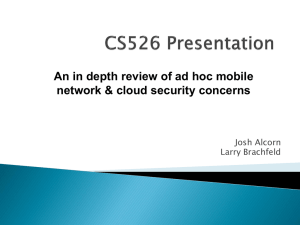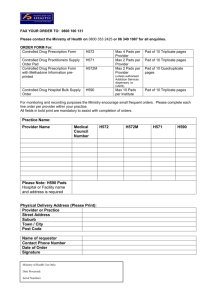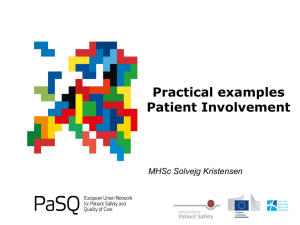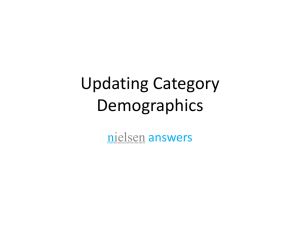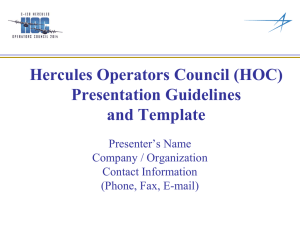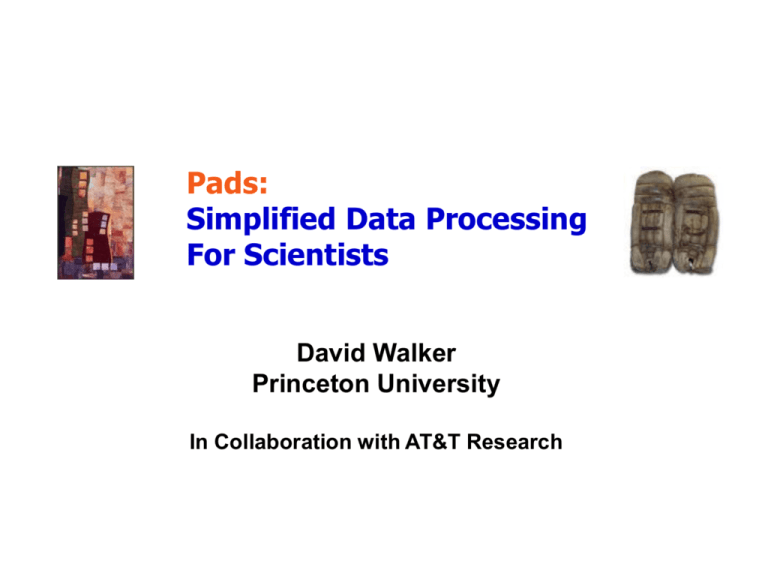
Pads:
Simplified Data Processing
For Scientists
David Walker
Princeton University
In Collaboration with AT&T Research
Who: actress Jennifer Aniston and
actor Brad Pitt
When: July 29, 2000
Where: The nuptials took place on
the grounds of TV producer Marcy
Carsey's Malibu estate
The Ceremony: As the sun sank
low in the California sky, two
hundred assembled guests watched
as John Aniston, known to daytime
television fans for his work on Days
of Our Lives, walked his daughter
down the aisle. Shielded by a
flower-bedecked canopy, the bride
and groom were able to say ....
3
Standard Data Formats
•
•
•
Behind the scenes, much of this information is represented in
standardized data formats
Standardized data formats:
–
–
–
–
–
Web pages in HTML
Pictures in JPEG
Movies in MPEG
“Universal” information format XML
Standard relational database formats
A plethora of data processing tools:
–
–
–
–
Visualizers (Browsers Display JPEG, HTML, ...)
Query languages allow users extract information (SQL, XQuery)
Programmers get easy access through standard libraries
• Java XML libraries --- JAXP
Many applications handle it natively and convert back and forth
• MS Word
4
Ad Hoc Data Formats
• Massive amounts of data are stored in XML, HTML or
relational databases but there’s even more data that
isn’t
• An ad hoc data format is any nonstandard data format
for which convenient parsing, querying, visualizing,
transformation tools are not available
– ad hoc data is everywhere.
5
Ad Hoc data from www.investors.com
Date: 3/21/2005 1:00PM PACIFIC
Investor's Business Daily ®
Stock List Name: DAVE
Stock Company
Symbol Name
AET
Aetna Inc
GE
General Electric Co
HD
Home Depot Inc
IBM
Intl Business Machines
INTC Intel Corp
Price Price
Volume EPS
RS
Price Change % Change % Change Rating Rating
73.68 -0.22
0%
31%
64
93
36.01
0.13
0%
-8%
59
56
37.99 -0.89
-2%
63%
84
38
89.51
0.23
0%
-13%
66
35
23.50
0.09
0%
-47%
39
33
Data provided by William O'Neil + Co., Inc. © 2005. All Rights Reserved.
Investor's Business Daily is a registered trademark of Investor's Business Daily, Inc.
Reproduction or redistribution other than for personal use is prohibited.
All prices are delayed at least 20 minutes.
6
Ad Hoc data from www.geneontology.org
!autogenerated-by: DAG-Edit version 1.419 rev 3
!saved-by: gocvs
!date: Fri Mar 18 21:00:28 PST 2005
!version: $Revision: 3.223 $
!type: % is_a is a
!type: < part_of part of
!type: ^ inverse_of inverse of
!type: | disjoint_from disjoint from $Gene_Ontology ; GO:0003673
<biological_process ; GO:0008150
%behavior ; GO:0007610 ; synonym:behaviour
%adult behavior ; GO:0030534 ; synonym:adult behaviour
%adult feeding behavior ; GO:0008343 ; synonym:adult feeding behaviour
% feeding behavior ; GO:0007631
%adult locomotory behavior ; GO:0008344 ;
...
7
Ad Hoc Data From
An Immune Response Simulation
0
8
1
3
2
7
3
5
4
8
5
5
6
6
....
125
8
3
2
6
0
(~6:0:0:0:0~1:0:0:0:1,1:1:0:0:0)
7
7
2
1
6
0
(~6:0:0:0:0~1:1:0:0:0)
37
6
2
1
5
0
(~5:0:0:0:0~1:1:0:0:0)
16
5
4
3
2
0
(~2:0:0:0:0~1:1:0:0:0,1:1:0:0:0,1:0:0:1:0)
161
2
2
1
1
0
(~1:0:0:0:0~1:0:0:1:0)
27
18
4
5
13
4
(~13:0:0:0:0~2:0:0:0:1,1:0:0:1:0,2:0:0:1:0)
50
5
1
0
5
0
5:0:0:0:0
8
Ad Hoc Data in Chemistry
O=C([C@@H]2OC(C)=O)[C@@]3(C)[C@]([C@](CO4)
(OC(C)=O)[C@H]4C[C@@H]3O)([H])[C@H]
(OC(C7=CC=CC=C7)=O)[C@@]1(O)[C@@](C)(C)C2=C(C)
[C@@H](OC([C@H](O)[C@@H](NC(C6=CC=CC=C6)=O)
C5=CC=CC=C5)=O)C1
O
O
O
O
OH
NH
O
HO
O
H
OH O
O
AcO
O
9
Ad Hoc Data from Web Server Logs (CLF)
207.136.97.49 - - [15/Oct/1997:18:46:51 -0700] "GET /tk/p.txt HTTP/1.0" 200 30
tj62.aol.com - - [16/Oct/1997:14:32:22 -0700] "POST /scpt/dd@grp.org/confirm
HTTP/1.0" 200 941
10
Ad Hoc Data: DNS packets
00000000: 9192 d8fb 8480 0001 05d8 0000 0000 0872 ...............r
00000010: 6573 6561 7263 6803 6174 7403 636f 6d00 esearch.att.com.
00000020: 00fc 0001 c00c 0006 0001 0000 0e10 0027 ...............'
00000030: 036e 7331 c00c 0a68 6f73 746d 6173 7465 .ns1...hostmaste
00000040: 72c0 0c77 64e5 4900 000e 1000 0003 8400 r..wd.I.........
00000050: 36ee 8000 000e 10c0 0c00 0f00 0100 000e 6...............
00000060: 1000 0a00 0a05 6c69 6e75 78c0 0cc0 0c00 ......linux.....
00000070: 0f00 0100 000e 1000 0c00 0a07 6d61 696c ............mail
00000080: 6d61 6ec0 0cc0 0c00 0100 0100 000e 1000 man.............
00000090: 0487 cf1a 16c0 0c00 0200 0100 000e 1000 ................
000000a0: 0603 6e73 30c0 0cc0 0c00 0200 0100 000e ..ns0...........
000000b0: 1000 02c0 2e03 5f67 63c0 0c00 2100 0100 ......_gc...!...
000000c0: 0002 5800 1d00 0000 640c c404 7068 7973 ..X.....d...phys
000000d0: 0872 6573 6561 7263 6803 6174 7403 636f .research.att.co
11
Who uses ad hoc data?
• Ad hoc data sources are everywhere
– containing valuable information of all kinds
– everybody wants it:
• corporations: acquire data files from partners, mergers and
acquisitions
• scientists:
chemists, physicists, biologists, economists,
computer scientists, network administrators, ...
• programmers:
just about all of us at one time or another
12
The challenge of ad hoc data
• What can we do about ad hoc data?
– how do we read it into programs?
– how do we detect errors?
– how do we correct errors?
– how do we query it?
– how do we view it?
– how do we gather statistics on it?
– how do we load it into a database?
– how do we transform it into a standard format like XML?
– how do we combine multiple ad data sources?
– how do we filter, normalize and transform it?
• In short:
how do we do all the things we take for
granted when dealing with standard formats in a
reliable, fault-tolerant and efficient, yet effortless way?
13
Most people use C / Perl / Shell scripts
• But:
– Writing hand-coded parsers is time consuming & error prone.
– Reading and maintaining them in the face of even small format
changes can be difficult.
– Such programs are often incomplete, particularly with respect
to errors.
– Not all that efficient unless the author invests extra effort
• For reliable & efficient data processing, we can do
better!
14
Why not use traditional parsers?
•
Overall, a fairly heavy-weight solution
– specifying a lexer and parser separately can be a barrier
• data specs as Lex and Yacc files are relatively complicated
• regular expressions and context-free grammars, while good for
programming language specs, aren’t necessarily the best
languages for specifying ad hoc data
– lexing and parsing tools only solve a small part of the problem
• internal data structures built by hand
• printer by hand
• transforms by hand
• viewers by hand
• query engine by hand
– people just do not do it
•
We can do better!
15
Enter Pads
•
•
Pads: a system for Processing Ad hoc Data Sources
Two main components:
– a data description language
• for concise and precise specifications of ad hoc data formats and
properties
– a compiler that automatically generates a suite of data processing tools
• robust libraries for C programming
– parser that flags all errors and automatically recovers
– printing utilities
– constraint checking utilities
• converter to XML
• a statistical profiler
– collects stats on common values appearing in all parts of the
data; records error stats
• visual interface & viewer (coming soon!)
16
Pads Tool Generation Architecture
gene data
Gene Ontology
description
Pads
Compiler
gene data
gene data
Statistical
Profiler
Tool
XML
Formatter
Tool
Profile
ACE 25%
BKJ 25%
...
<foo s d/>
<bar dd h/>
Viewer
Tool
17
Pads Tool Generation Architecture
Pads Base
Library
Gene Ontology
description
Pads
Compiler
Gene
Ontology
Generated
Parser
Glue code
for statistical
profile
Gene Ontology
Statistical Profiler
18
Pads Programmer Tools
Pads Base
Library
Gene Ontology
description
Pads
Compiler
Gene
Ontology
Generated
Parser
Ad Hoc
User
Program in C
Ad Hoc User
Program
19
The Statistical Profiler Tool
• for each part of a data source, profiler reports errors &
most common values.
• from example weblog data:
<top>.length : uint32
+++++++++++++++++++++++++++++++++++++++++++
good: 53544
bad: 3824
pcnt-bad: 6.666
min: 35
max: 248591
avg: 4090.234
top 10 values out of 1000 distinct values:
tracked 99.552% of values
val: 3082
val: 170
val: 43
.....
count: 1254
count: 1148
count: 1018
%-of-good: 2.342
%-of-good: 2.144
%-of-good: 1.901
20
The Statistical Profiler Tool
• ad hoc data is often poorly documented or out-of-date
• even the documentation of weblog data from our
textbook was missing some information:
good: 53544
bad: 3824
pcnt-bad: 6.666
– web server sometimes return a ‘-’ instead of length of bytes,
which wasn’t mentioned in the textbook
• data descriptions can be written in a iterative fashion
–
use the profiler at each stage to uncover additional
information about the data and refine the description
21
PADS language
•
Based on Type Theory
– in most modern programming languages, types (int, bool, struct, object
...) describe program data
• the source of most of my research
– in Pads, types describe
• physical data formats,
• semantic properties of data, and
• a mapping into an internal program representation (ie, a parser)
– in Pads, types include
• base types for ints of different kinds, strings of different kinds, dates,
urls, ...
• structs and arrays for reading sequences
• unions, switched unions and enums for alternatives
• parameterized types to express dependencies & constraints
• recursive types to express recursive hierarchies (coming soon!)
– Can describe ASCII, binary, and mixed data formats.
22
Future Work
• Ad Hoc Data Transformation & Integration
– language and compiler support for moving data from the format
you are given to the format you really want
• specifying simple transforms:
permuting, dropping,
computing fields; normalizing representations of dates,
times, places ...
• correcting errors
• integrating multiple sources
• Pads Applications
– genomics data (with Olga Troyanskaya, Princeton CS)
– networking and telephony data (AT&T)
– financial data (Richard Liao, Princeton ORFE)
23
Challenges of Ad Hoc Data Revisited
•
Data arrives “as is”
– Format determined by data source, not consumers.
• The Pads language allows consumers to describe data in just
about any format.
– Often has little documentation.
• A Pads description can serve as documentation for a data source.
• The statistical profiler helps analysts understand data.
– Some percentage of data is “buggy.”
• Constraints allow consumers to express expectations about data.
• Parsers check for errors and say where errors are located.
•
Ad hoc data is a rich source of information for financial analysts,
chemists, biologists, computer scientists, if they could only get at it.
– Pads generates a collection of useful tools automatically from data
descriptions
24
Pads Summary
• The overarching goal of Pads is to make
understanding, analyzing and transforming ad hoc data
an effortless task.
• We do so with new programming language technology
based on the principles of Type Theory.
AT&T Research:
Kathleen Fisher
Mary Fernandez
Joel Gottlieb
Robert Gruber (now Google)
Ricardo Medel (summer intern)
Princeton:
Mark Daly (UGrad)
Yitzhak Mandelbaum (Grad)
David Walker
http://www.padsproj.org/
25
End!


